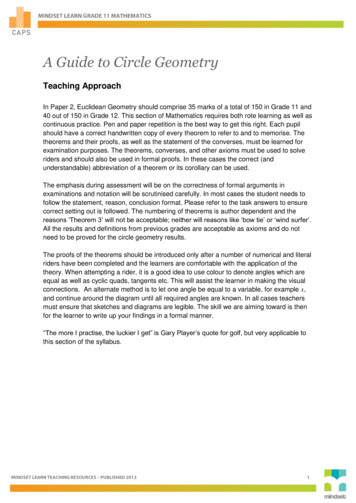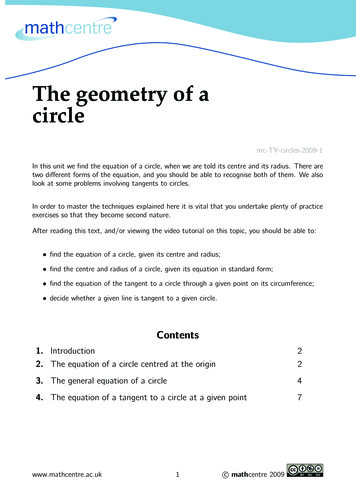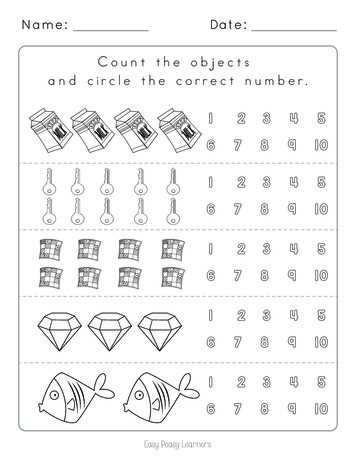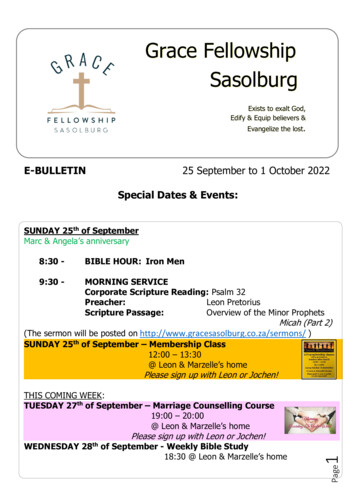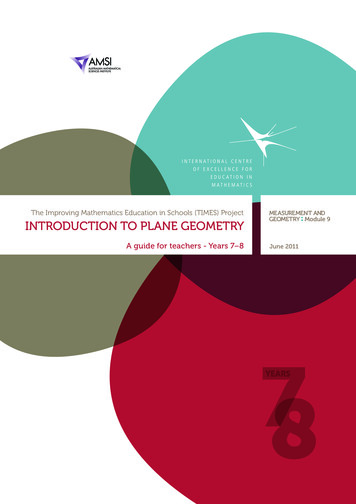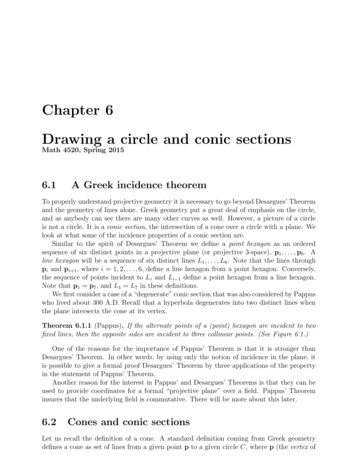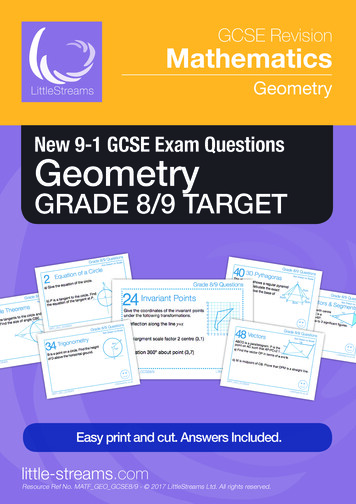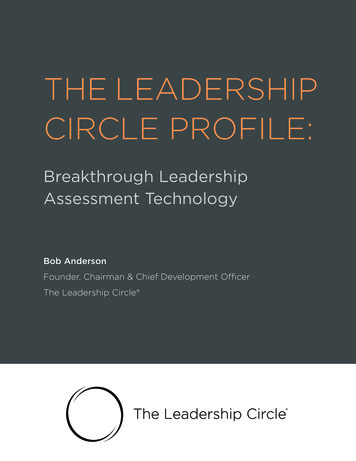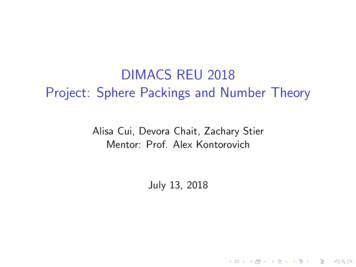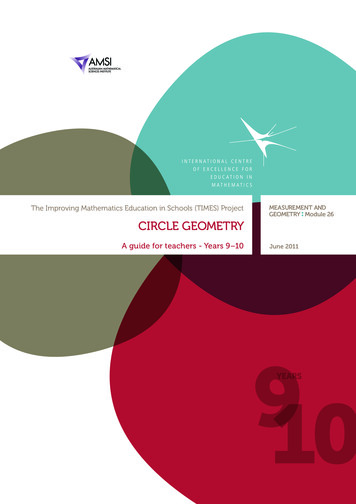
Transcription
The Improving Mathematics Education in Schools (TIMES) Project EASUREMENT ANDMGEOMETRY Module 26CIRCLE GEOMETRYA guide for teachers - Years 9–10June 2011910YEARS
Circle Geometry(Measurement and Geometry: Module 26)For teachers of Primary and Secondary Mathematics510Cover design, Layout design and Typesetting by Claire HoThe Improving Mathematics Education in Schools (TIMES)Project 2009‑2011 was funded by the Australian GovernmentDepartment of Education, Employment and WorkplaceRelations.The views expressed here are those of the author and do notnecessarily represent the views of the Australian GovernmentDepartment of Education, Employment and Workplace Relations. The University of Melbourne on behalf of the InternationalCentre of Excellence for Education in Mathematics (ICE‑EM),the education division of the Australian Mathematical SciencesInstitute (AMSI), 2010 (except where otherwise indicated). Thiswork is licensed under the Creative Commons AttributionNonCommercial-NoDerivs 3.0 Unported nd/3.0/
The Improving Mathematics Education in Schools (TIMES) ProjectMEASUREMENT ANDGEOMETRY Module 26CIRCLE GEOMETRYA guide for teachers - Years 9–10June 2011Peter BrownMichael EvansDavid HuntJanine McIntoshBill PenderJacqui Ramagge910YEARS
{4}A guide for teachersCIRCLEGEOMETRYASSUMED KNOWLEDGE Introductory plane geometry involving points and lines, parallel lines and transversals,angle sums of triangles and quadrilaterals, and general angle-chasing. Experience with a logical argument in geometry written as a sequence of steps, eachjustified by a reason. Ruler-and-compasses constructions. The four standard congruence tests and their application to proving properties of andtests for special triangles and quadrilaterals. The four standard similarity tests and their application. Trigonometry with triangles.MOTIVATIONMost geometry so far has involved triangles and quadrilaterals, which are formed byintervals on lines, and we turn now to the geometry of circles. Lines and circles are themost elementary figures of geometry – a line is the locus of a point moving in a constantdirection, and a circle is the locus of a point moving at a constant distance from somefixed point – and all our constructions are done by drawing lines with a straight edgeand circles with compasses. Tangents are introduced in this module, and later tangentsbecome the basis of differentiation in calculus.The theorems of circle geometry are not intuitively obvious to the student, in fact mostpeople are quite surprised by the results when they first see them. They clearly need to beproven carefully, and the cleverness of the methods of proof developed in earlier modulesis clearly displayed in this module. The logic becomes more involved – division into casesis often required, and results from different parts of previous geometry modules are oftenbrought together within the one proof. Students traditionally learn a greater respectand appreciation of the methods of mathematics from their study of this imaginativegeometric material.
The Improving Mathematics Education in Schools (TIMES) ProjectThe theoretical importance of circles is reflected in the amazing number and variety ofsituations in science where circles are used to model physical phenomena. Circles are thefirst approximation to the orbits of planets and of their moons, to the movement of electronsin an atom, to the motion of a vehicle around a curve in the road, and to the shapes ofcyclones and galaxies. Spheres and cylinders are the first approximation of the shape ofplanets and stars, of the trunks of trees, of an exploding fireball, and of a drop of water, andof manufactured objects such as wires, pipes, ball-bearings, balloons, pies and wheels.CONTENTRADII AND CHORDSWe begin by recapitulating the definition of a circle and the terminology used for circles.Throughout this module, all geometry is assumed to be within a fixed plane. A circle is the set of all points in the plane that are a fixed distance (the radius) from afixed point (the centre). Any interval joining a point on the circle to the centre An interval joining two points on the circle is called a chord.secanteterdiamradiusis called a radius. By the definition of a circle, any two radiihave the same length. Notice that the word ‘radius’ is beingused to refer both to these intervals and to the commonlength of these intervals.chord A chord that passes through the centre is called a diameter. Since a diameter consistsof two radii joined at their endpoints, every diameter has length equal to twice theradius. The word ‘diameter’ is use to refer both to these intervals and to their commonlength. A line that cuts a circle at two distinct points is called a secant. Thus a chord is theinterval that the circle cuts off a secant, and a diameter is the interval cut off by asecant passing through the centre of a circle centre.{5}
{6}A guide for teachersSymmetries of a circleCircles have an abundance of symmetries: A circle has every possible rotation symmetry aboutits centre, in that every rotation of the circle about itscentre rotates the circle onto itself.O If AOB is a diameter of a circle with centre O, then theBreflection in the line AOB reflects the circle onto itself.Thus every diameter of the circle is an axis of symmetry.OAAs a result of these symmetries, any point P on a circlecan be moved to any other point Q on the circle. This canbe done by a rotation through the angle /POQ aboutthe centre. It can also be done by a reflection in the diameterAOB bisecting /POQ. Thus every point on a circle is essentiallythe same as every other point on the circle – no other figure inthe plane has this property except for lines.PB2OA2QEXERCISE 1a Identify all translations, rotations and reflections of the planethat map a line ℓ onto itself.b Which of the transformations in part a map a particular point Pon ℓ to another particular point Q on ℓ.QPCongruence and similarity of circlesAny two circles with the same radius are congruent –if one circle is moved so that its centre coincideswith the centre of the other circle, then it followsfrom the definition that the two circles will coincide.More generally, any two circles are similar –move one circle so that its centre coincideswith the centre of the other circle, then applyan appropriate enlargement so that it coincidesexactly with the second circle.rORZRrOZA circle forms a curve with a definite length, called the circumference, and it encloses adefinite area. The similarity of any two circles is the basis of the definition of π, the ratio ofthe circumference and the diameter of any circle. We saw in the module, The Circles thatif a circle has radius r, thencircumference of the circle 2πr andarea of the circle πr2
The Improving Mathematics Education in Schools (TIMES) ProjectARadii and chordsLet AB be a chord of a circle not passing through itscentre O. The chord and the two equal radii OA andBO form an isosceles triangle whose base is the chord.The angle AOB is called the angle at the centresubtended by the chord.OBIn the module, Rhombuses, Kites and Trapezia we discussed the axis of symmetryof an isosceles triangle. Translating that result into the language of circles:TheoremLet AB be a chord of a circle with centre O. The following three lines coincide: The bisector of the angle /AOB at the centre subtended by the chord.B The interval joining O and the midpoint of the chord AB.A The perpendicular bisector of the chord AB.OTrigonometry and chordsConstructions with radii and chords give plenty of opportunity for using trigonometry.EXERCISE 2In the diagram to the right, the interval AM subtends an angle at the centre O of a circle of radius 1. Show that:aAM sin O1b OM cos ABMThis exercise shows that sine can be regarded as the length of the semichord AM in acircle of radius 1, and cosine as the perpendicular distance of the chord from the centre.Until modern times, tables of sines were compiled as tables of chords or semichords, andthe name ‘sine’ is conjectured to have come in a complicated and confused way from theIndian word for semichord.Arcs and sectorsLet A and B be two different points on a circle withcentre O. These two points divide the circle into twoopposite arcs. If the chord AB is a diameter, thenthe two arcs are called semicircles. Otherwise, onearc is longer than the other – the longer arc is calledthe major arc AB and the shorter arc is called theminor arc AB.Aminor arcOmajor arcB{7}
{8}A guide for teachersNow join the radii OA and OB. The reflex angle /AOB is called the angle subtended bythe major arc AB. The non-reflex angle /AOB is called the angle subtended by the minorarc AB, and is also the angle subtended by the chord AB.The two radii divide the circle into two sectors, called correspondingly the major sectorOAB and the minor sector OAB.It is no surprise that equal chords and equal arcs both subtend equal angles at the centreof a fixed circle. The result for chords can be proven using congruent triangles, butcongruent triangles cannot be used for arcs because they are not straight lines, so weneed to identify the transformation involved.Theorema Equal chords of a circle subtend equal angles at the centre.bEqual arcs of a circle subtend equal angles at the centre.Proofa In the diagram to the right, AOB POQ (SSS)ABso /AOB /POQ (matching angles of congruenttriangles)OPQb Rotate the circle so that the arc PQ coincides with thearc AB or BA. Then the angles /POQ and /AOB coincide,and hence are equal.SegmentsA chord AB of a circle divides the circle into two segments. If AB is a diameter, the twocongruent segments are called semicircles – the word ‘semicircle’ is thus used bothfor the semicircular arc, and for the segment enclosed by the arc and the diameter.Otherwise, the two segments are called a major segment and a minor segment.The word ‘subtend’The word ‘subtend’ literally means ‘holds under’, and is often used in geometry to describean angle.Suppose that we have an interval or arc AB and a point P not on AB. Join the intervals APand BP to form the angle /APB. We say that the angle /APB is the angle subtended bythe interval or arc AB at the point P.
The Improving Mathematics Education in Schools (TIMES) ProjectANGLES IN A SEMICIRCLELet AOB be a diameter of a circle with centre O, and let P beany other point on the circle. The angle /APB subtended at Pby the diameter AB is called an angle in a semicircle. This angleis always a right angle – a fact that surprises most people whenthey see the result for the first time.{9}PBOATheoremAn angle in a semicircle is a right angle.PProofBLet AB be a diameter of a circle with centre O,and let P be any other point on the circle.OAJoin the radius PO, and let a /A and /B.2a 2 180 a 90 ,so/APB 90 , as required.This famous theorem is traditionally ascribed to the Greek mathematician Thales,the first known Greek mathematician.EXERCISE 3PThales’ theorem can also be proven using the following test for arectangle developed in the module, Parallelograms and Rectangles.BA quadrilateral whose diagonals are equal and bisect each otheris a rectangle.Join the radius PO and produce it to a diameter POQ, then join upthe quadrilateral APBQ. Explain why /APB is a right angle.OAQ
{10}A guide for teachersConstructing a right angle at the endpoint of an intervalThales’ theorem gives a quick way to construct a rightangle at the endpoint of an interval AX.Q1 Choose a point O above the interval AX.2 Draw a circle with centre O through A crossingAX again at P.OAPX3 Draw the radius PO and produce it to a diameter POQ.4 Join AQ, then /PAQ 90 .The converse theoremThe angle in a semicircle theorem has a straightforward converse that is best expressed asa property of a right-angled triangle:TheoremRBThe circle whose diameter is the hypotenuse of a right-angledtriangle passes through all three vertices of the triangle.MProofLet ABC be right-angled at C, and let M be the midpoint ofthe hypotenuse AB.CAWe need to prove that MC MA MB. Complete the rectangle ACBR. BecauseACBR is a rectangle, its diagonals bisect each other and are equal. Hence M is themidpoint of the other diagonal CR, and AM BM CM RM .This is an excellent example of the way ideas in geometry fit together – a significanttheorem about circles has been proven using a property of rectangles.Two practical situations to illustrate the converse theoremA set of points in the plane is often called a locus. The term is used particularly whenthe set of points is the curve traced out by a moving point. For example, a circle can bedefined as the locus of a point that moves so that its distance from some fixed point isconstant. The two examples below use the converse of the angle in a semicircle theoremto describe a locus.EXERCISE 4A photographer is photographing the ornamental frontof a building. He wants the two ends of the front tosubtend a right angle at his camera. Describe the setof all positions where he can stand.
The Improving Mathematics Education in Schools (TIMES) Project{11}EXERCISE 5A plank of length ℓ metres is initially resting flush against a wall,but it slips outwards, with its top sliding down the wall and itsfoot moving at right angles to the wall. What path does themidpoint of the plank trace out?Bℓ2Mℓ2OAANGLES AT THE CENTRE AND CIRCUMFERENCEThe angle-in-a-semicircle theorem can be generalised considerably. In each diagrambelow, AB is an arc of a circle with centre O, and P is a point on the opposite arc. The arcAB subtends the angle /AOB at the centre. The arc also subtends the angle /APB, calledan angle at the circumference subtended by the arc AB.PPPAOABOB180 ABIn the middle diagram, where the arc is a semicircle, the angle at the centre is a straightangle, and by the previous theorem, the angle at the circumference is a right angle –exactly half. We shall show that this relationship holds also for the other two cases, whenthe arc is a minor arc (left-hand diagram) or a major arc (right-hand diagram). The proofuses isosceles triangles in a similar way to the proof of Thales’ theorem.TheoremAn angle at the circumference of a circle is half the angle at the centre subtended by thesame arc.ProofLet AB be an arc of a circle with centre O, and let P be any point on the opposite arc.We need to prove /AOB 2/APB. The proof divides into three cases, dependingon whether:Case 1: O lies inside ABPCase 2: O lies on APB Case 3: O lies outside APB.PPOOAQBAQBAOPB
{12}A guide for teachersCase 1: Join PO and produce PO to Q. Then OA OB OP (radii), so we have twoisosceles triangles OAP and OAQ.Let/OAP a and /OBP .Then/APO a(base angles of isosceles OAP)and/BPO (base angles of isosceles OBP).Hence/AOQ 2a(exterior angle of OAP)and/BOQ 2 so(exterior angle of OBP),/AOB 2a 2 2(a ) 2 /APB.EXERCISE 6Complete the proof in the other two cases.EXAMPLEA punter stands on the edge of a circular racing track. With his binoculars he is followinga horse that is galloping around the track at one revolution a minute. Explain why thepunter’s binoculars are rotating at a constant rate of half a revolution per minute.SOLUTIONAs the horse moves from position A to position B, the horsemoves an angle /AOB 2 about the centre O of the track.The angle at the circumference is half the angle at the centre,so /APB which means that the punter’s binoculars rotate by anangle the horse moves from A to B. Hence the punter is rotating hisbinoculars at a constant rate that is half the rate at which the horse isrotating about the centre.A2OBPAngles subtended by the same arcPIn the diagram to the right, the two angles /APB and /AQBare subtended by the same (minor) arc AB. Each angle is halfthe angle /AOB at the centre subtended by the same arc,so /APB /AQB.This corollary of the previous theorem is a particularly significantresult about angles in circles:QOATheoremTwo angles at the circumference subtended by the same arc are equal.Thales’ theorem is a special case of this theorem.B
The Improving Mathematics Education in Schools (TIMES) Project{13}Some alternative terminologyThe last two theorems are often expressed in slightly different language, and someexplanation is needed to avoid confusion.1 An angle subtended by an arc is often said to be standing on the arc. With thisterminology, the two theorems become:-- An angle at the circumference of a circle is half the angle at the centre standingon the same arc.-- Two angles at the circumference standing on the same arc are equal.In the context of these two theorems, it is best to avoid the phrases ‘standing on a chordAB’ and ‘subtended by a chord AB , because we need to distinguish between anglessubtended by the major arc AB and angles subtended by the minor arc AB.P2 In the upper diagram to the right, the angle /APB is calledan angle in the (major) segment. Notice that it actually stands onthe minor arc AB, which can be confusing. We have already usedthis terminology before in speaking about an ‘angle in asemicircle’. With this terminology, the last theorem becomes: ABTwo angles in the same segment of a circle are equal.QThe situation is illustrated in the lower diagram to the right.PBAExtension – The orthocentre of a triangleAn altitude of a triangle is a perpendicular from any of the three vertices to the oppositeside, produced if necessary. The two cases are illustrated in the diagrams below.There are three altitudes in a triangle. The following theorem proves that they concurrentat a point called the orthocentre H of the triangle. It is surprising that circles can be usedto prove the concurrence of the altitudes.TheoremCThe altitudes of a triangle are concurrent.AB
{14}A guide for teachersAEXERCISE 7QIn the diagram to the right, the altitudes AP andBQ meet at H. The interval CH is produced to meet AB ,produced if necessary, at R. We need to prove that CR AB.a Explain why Q, H, P and C are concyclic, and drawthe circle.RBHCPb Explain why A, B, P and Q are concyclic, and draw the circle.c Join the common chord PQ, and explain why /QCH /QPH.d Explain why /APQ /ABQ.e Use ABQ and ACR to explain why CR AB.CYCLIC QUADRILATERALSIn the module, Congruence, we showed how to draw thecircumcircle through the vertices of any triangle. To do this, weshowed that the perpendicular bisectors of its three sides areconcurrent, and that their intersection, called the circumcentreof the triangle, is equidistant from each vertex.No other circle passes through these three vertices. If we triedto take as centre a point P other than the circumcentre, then Pwould not lie on one of the perpendicular bisectors, so it couldnot be equidistant from the three vertices.When there are four points, we can always draw a circle throughany three of them (provided they are not collinear), but only inspecial cases will that circle pass through the fourth point. A cyclicquadrilateral is a quadrilateral whose vertices all lie on a circle.This is the last type of special quadrilateral that we shall consider.Constructing the circumcircle of a cyclic quadrilateralSuppose that we are given a quadrilateral that is known to becyclic, but whose circumcentre is not shown (perhaps it has beenrubbed out). The circumcentre of the quadrilateral is thecircumcentre of the triangle formed by any three of its vertices,so the construction to the right will find its circumcentre.OThe opposite angles of a cyclic quadrilateralThe distinctive property of a cyclic quadrilateral is that its opposite angles are supplementary.The following proof uses the theorem that an angle at the circumference is half the angle atthe centre standing on the same arc.
The Improving Mathematics Education in Schools (TIMES) Project{15}TheoremThe opposite angles of a cyclic quadrilateral are supplementary.ProofLet ABCD be a cyclic quadrilateral with O the centre of the circle.Join the radii OB and OD. Let a and g be the angles at the centre, as shown on thediagram.Thena g 360 Also/A 2 aand/C 2 gso1(angles on the same arc BCD)11B(angles in a revolution at O)(angles on the same arc BAD)COA1D/A /C 2 a 2 g 180 Hence also /ABC /ADC 180 (angle sum of quadrilateral ABCD)Here is an alternative proof using the fact that two angles in the same segment are equal.EXERCISE 8Join the diagonals AC and BD of the cyclic quadrilateral ABCD. Let a, b, g and d be theangles shown.Ba Give a reason why /DBC ab What other angles have sizes b, g and d?c Prove that a b g d 180 .CAd Hence prove that the opposite angles of ABCDare supplementary.DExterior angles of a cyclic quadrilateralAn exterior angle of a cyclic quadrilateral is supplementary to the adjacent interiorangle, so is equal to the opposite interior angle. This gives us the corollary to the cyclicquadrilateral theorem:TheoremBAn exterior angle of a cyclic quadrilateral is equalto the opposite interior angle.ProofCPAIn the diagram to the right, BC is produced to P toform the exterior angle /PCD. This exterior angleand /A are both supplementary to /BCD, so they are equal.D
{16}A guide for teachersEXERCISE 9AShow that AP CR in the diagram to the right.BCPXRQBEXERCISE 10If a cyclic trapezium is not a rectangle, show that the other twosides are not parallel, but have equal length.CAPDMExtension – A test for a cyclic quadrilateralThe property of a cyclic quadrilateral proven earlier, that its opposite angles aresupplementary, is also a test for a quadrilateral to be cyclic. That is the converse is true.This theorem completes the structure that we have been following – for each specialquadrilateral, we establish its distinctive properties, and then establish tests for it.The proof uses ‘proof by contradiction’, and is thus a little more difficult than otherYear 10 material.TheoremIf the opposite angles of a quadrilateral are supplementary, then the quadrilateral is cyclic.ProofLet ABCD be a quadrilateral with /A /C 180 .Construct the circle through A, B and D, and suppose, by way of contradiction, thatthe circle does not pass through C.Let DC, produced if necessary, meet the circle againat X, and join XB.DThen /A and /BXD are supplementary becauseABXD is a cyclic quadrilateral,BAso the angles /DXB and /DCB are equal, so XB CBHence XB and CB are the same line, so C and Xcoincide, that is the circle does pass through C.CX
The Improving Mathematics Education in Schools (TIMES) Project{17}EXERCISE 11Prove the following alternative form of the above theorem:If an exterior angle of a quadrilateral equals the opposite interior angle, then thequadrilateral is cyclic.EXERCISE 12DIn the diagram to the right, the two adjacent acute angles ofthe trapezium are equal.Prove that the trapezium is cyclic.CAAExtension – The sine rule and circle geometryAThe sine rule states that for any triangle ABC, the ratioof any side over the sine of its opposite angle is a constant,asin A bsin B bccsin CEach term is the ratio of a length over a pure number, so theircommon value seems to be a length. Thus it reasonable to ask,what is this common length? The answer is a surprise – thecommon length is the diameter of the circumcircle throughthe vertices of the triangle.The proof of this result provides a proof of the sine rulethat is independent of the proof given in the module,Further Trigonometry.CaBAbcOaBCTheoremIn any triangle ABC,asin A bsin B sinc C 2R, where R is the radius of the circumcircle.ProofLet O be the centre of the circumcircle through A, B and C, and let /A a.It is sufficient to prove thatasin Ais the diameter of the circumcircle.There are three cases, as shown below.AAACbcPaCPOOBaCCase 1: A and O lie onthe same side of BC.BCase 2: A and O lie onopposite sides of BC.In cases 1 and 2, construct the diameter BOP, and join PC .OBCase 3: O lies on BC
{18}A guide for teachersEXERCISE 13a Complete the following steps of the proof in Case 1.i Explain why /BCP 90 and /P aii Complete the proof using BCP.b Complete the following steps of the proof in Case 2.i Explain why /BCP 90 and sin P sin aii Complete the proof using BCP.c Complete the proof in Case 3.Tangents to circlesA tangent to a circle is a line that meets the circle at just one point. The diagram belowshows that given a line and a circle, can arise three possibilities: The line may be a secant, cutting the circle at two points. The line may be a tangent, touching the circle at just one point. The line may miss the circle entirely.The words ‘secant’ and ‘tangent’ are from Latin – ‘secant’ means ‘cutting’ (as in ‘crosssection’), and ‘tangent’ means ‘touching’ (as in ‘tango’).tangentsecantThe point where a tangent touches a circle is called a point of contact. It is notimmediately obvious how to draw a tangent at a particular point on a circle, or evenwhether there may be more than one tangent at that point. The following theorem makesthe situation clear, and uses Pythagoras’ theorem in its proof.TheoremLet T be a point on a circle with centre O.a The line through T, perpendicular to the radius OT, is a tangent to the circle.b This line is the only tangent to the circle at T.c Every point on the tangent, except for T itself, lies outside the circle.
The Improving Mathematics Education in Schools (TIMES) ProjectPProofFirst we prove parts a and c. Let ℓ be the line through Tperpendicular to the radius OT. Let P be any other point on ℓ,and join the interval OP. Then using Pythagoras’ theoremin OTP,TOP2 OT 2 PT 2; which is greater than OT 2,so OP is greater than the radius OT. Hence P lies outside the circle, and not on it.This proves that the line ℓ is a tangent, because it meets the circle only at T. It alsoproves that every point on ℓ, except for T, lies outside the circle.It remains to prove part b, that there is no other tangentto the circle at T.Let t be a tangent at T, and suppose, by way ofcontradiction, that t were not perpendicular to OT. LetM be the foot of the perpendicular from O to t, andconstruct the point U on t,on the other side of M, sothat UM MT. Then using Pythagoras’ theorem in OMT and OMU,tUMTOOT2 OM2 MT2 OM2 MU2 OU2,So OU OT. Hence U also lies on the circle, contradicting the fact that t is a tangent.Construction – Tangents from an external pointUsing this radius and tangent theorem, and theangle in a semi circle theorem, we can now constructtangents to a circle with centre O from a point P outsidethe circle.TP1 Join OP and construct the midpoint M of OP .OMU2 Draw the circle with centre M through O and P, and let it meet the circle at T and U.The angles /PTO and /PUO are right angles, because they are angles in a semicircle.Hence the lines PT and PU are tangents, because they are perpendicular to the radii OTand OU, respectively.Tangents from an external point have equal lengthIt is also a simple consequence of the radius-and-tangent theorem that the two tangentsPT and PU have equal length.Notice that here, and elsewhere, we are using the word ‘tangent’ in a second sense, tomean not the whole line, but just the interval from an external point to the pointof contact.TheoremTangents to a circle from an external point have equal length.{19}
{20}A guide for teachersEXERCISE 14Prove this result using either congruence or Pythagoras’ theorem.Tangents and trigonometryThe right angle formed by a radius and tangent gives further opportunities for simpletrigonometry. The following exercise shows how the names ‘tangent’ and ‘secant’, andtheir abbreviations tan and sec , came to be used in trigonometry. In a circle of radius 1,the length of a tangent subtending an angle at the centre is tan , and the length of thesecant from the external point to the centre is sec .TEXERCISE 15P1A tangent PT to a circle of radius 1 touches the circleat T and subtends an angle at the centre O. Show thatOPT tan and PO sec 1where the trigonometry function secant is defined by sec cos.Quadrilaterals with incirclesThe following exercise involves quadrilaterals within which an incircle can be drawn tangentto all four sides. These quadrilaterals form yet another class of special quadrilaterals.EXERCISE 16AThe sides of a quadrilateral are tangent to a circleBDdrawn inside it. Show that the sums of opposite sidesof the quadrilateral are equal.CCommon tangents and touching circlesA line that is tangent to two circles is called a common tangent to the circles. When thepoints of contact are distinct, there are two cases, as in the diagrams below. The twocircles lie on the same side of a direct common tangent, and lie on opposite sides of anindirect common tangent.Direct common tangentIndirect common tangent
The Improving Mathematics Education in Schools (TIMES) ProjectTwo circles are said to touch at a common point T if there is a common tangent to bothcircles at the point T. As in the diagram below, the circles touch externally when they areon opposite sides of the common tangent, and touch internally when they are on thesame side of the common tangent.TTProvided that they are distinct, touching circles have only the one point in common.EXERCISE 17a How many common tangents are there to two circles when the circles:i are one inside the other,ii touch internally,iii overlap,iv touch externally,v are next to each other without touching?b Prove that the intervals between the points of contact on two indirect commontangents have equal length.c Prove that the intervals between the points of contact on two direct common tangentshave equal length.Extension - The incentre of a triangleWe are now in a position to prove a wonderful theoremon the angle bisectors of a triangle. These three bisectorsare concurrent, and their point of intersection is calledthe incentre of the triangle. The incentre is the centre ofthe incircle tangent to all three sides of the triangle, as inBIACthe diagram to t
Circle Geometry (Measurement and Geometry: Module 26) For teachers of Primary and Secondary Mathematics 510 Cover design, Layout design and Typesetting by Claire Ho The Improving Mathematics Education in Schools (TIMES) Project 2009‑2011 was funded by the Australian Government Department of Education, Employment and Workplace Relations.
